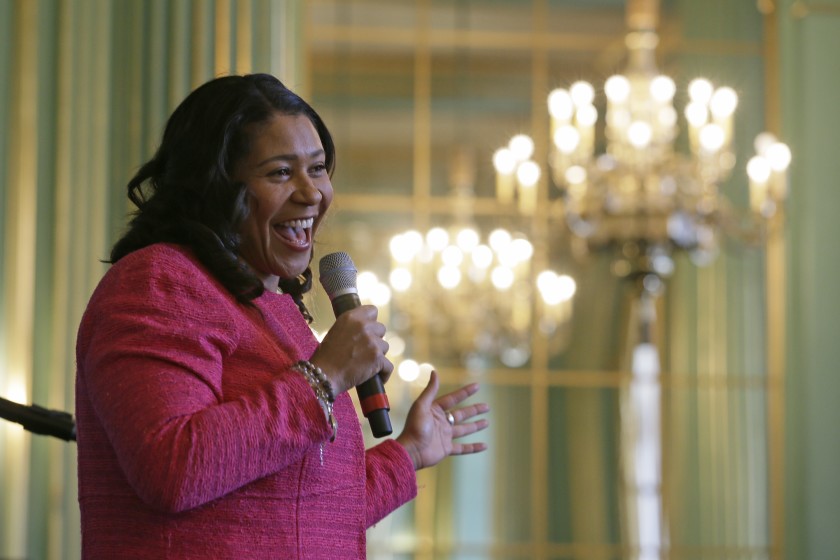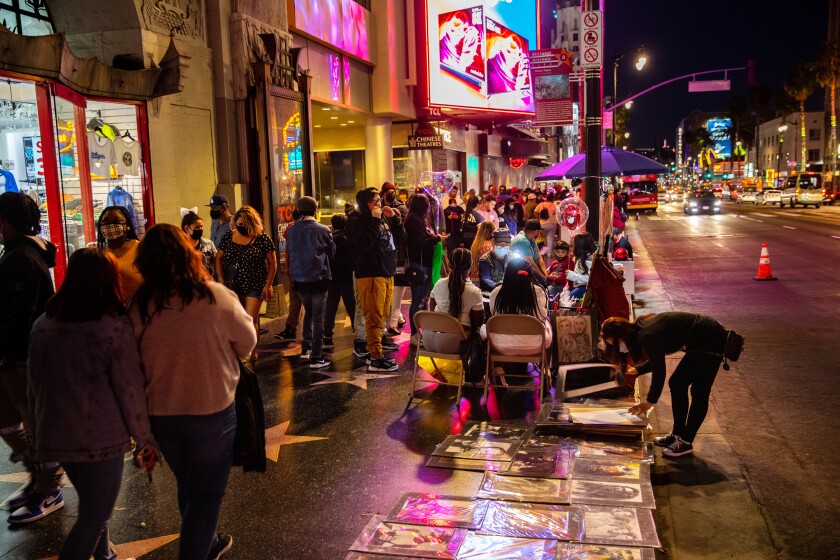With coronavirus cases continuing to dip and COVID-19 vaccine distribution steadily improving, more California counties are rapidly reaching a point where they can further untether themselves from the strictest rules imposed to combat the pandemic.
For Los Angeles and Orange counties, the next milestone could come as early as next week, when they are poised to potentially progress from the state-defined red tier of COVID-19 restrictions to the more-lenient orange tier.
Neither county has ever made it that far through California’s reopening roadmap, a four-category, color-coded system that was unveiled in late August.
Such a move would position them to relax a host of restrictions — a likely welcome development for pandemic-weary Californians and financially battered businesses, but one that has sparked warnings and pleas for caution from health officials.
“We are close to the finish line,” a city health official said. But some warn of a rebound of COVID-19 if residents relax their guard.
What does it mean to enter the orange tier?
Within California’s tier framework, counties are categorized based on three factors: coronavirus case rates, adjusted based on the number of tests performed; the rate of positive test results; and a health-equity metric intended to ensure that the positive test rate in poorer communities is not significantly higher than the county’s overall figure.
To enter the orange tier, for instance, a county must have an adjusted rate of 3.9 or fewer new coronavirus cases per 100,000 people each day, a test positivity rate of under 5% and a health-equity metric of less than 5.3%.
Those benchmarks remain out of reach for much of the state at the moment. As of this week, only 11 of California’s 58 counties had reached the orange tier or the final yellow tier.
The two counties have now banked one week’s worth of the metrics necessary to progress into the orange tier, which would mean more businesses could open.
Getting that far, however, empowers counties to more broadly and significantly reopen their economies.
In the orange tier:
- Counties can allow bars to reopen outdoors, with modifications, without needing to serve food.
- Capacity restrictions are lifted in stores (although pandemic safety modifications still apply); houses of worship, museums, zoos and aquariums can raise their indoor capacity from 25% to 50%; restaurants and movie theaters can raise indoor capacity from 25% or 100 people (whichever is fewer) to 50% capacity or 200 people; and indoor gyms and yoga studios increase capacity from 10% to 25%. Bowling alleys can reopen with modifications at 25% capacity. Card rooms and satellite wagering sites can also reopen indoors at 25% capacity.
- Offices in nonessential industries can reopen, but workers should be encouraged to work remotely.
- Amusement parks — which can open starting April 1 in red-tier counties — would be allowed to expand their attendance to 25% capacity.
- The capacity limit for outdoor sports and live performances, also effective April 1, rises to 33% for counties in the orange tier.
The state’s framework sets the floor in terms of restrictions. Local-level health departments have the power to keep stricter rules in place, if they so choose.
A growing number of California’s health departments have broken with state guidelines and made COVID-19 vaccines available to more people, sparking joy from some and envy among others.
Where do L.A. and Orange counties stand?
L.A. and Orange counties have met all the requisite orange tier thresholds, according to the latest state data released Tuesday. Their most recently calculated adjusted case rates were 3.7 and 3.5, respectively.
However, counties must log two straight weeks of qualifying data to advance to a less restrictive tier. Should their numbers hold, L.A. and Orange counties could move forward as soon as next week.
“It’s certainly good news that we’re making progress, reducing transmission across the county,” L.A. County Public Health Director Barbara Ferrer said Tuesday. “However, we continue to remain concerned about the potential risks that can thwart our progress.”
Who else already moved to orange?
Six counties moved into the orange tier this week: San Francisco, Santa Clara, Marin, Trinity, Lassen and Yolo. Already in that tier are Mariposa, Plumas and San Mateo counties. Just two counties, Alpine and Sierra, have made it to yellow.
San Francisco Mayor London Breed said that moving into the orange tier means “downtown is going to start to come alive again,” and “many of the restaurants and the coffee shops in the places that you’ve seen that have been struggling will hopefully be able to open again.”
Even San Francisco Public Health Director Dr. Grant Colfax, known for giving gloomy assessments during the pandemic, was upbeat.
“We are close to the finish line,” he said.
So it’s all good news?
Not exactly. While the additional reopenings are testament to the progress California has made in the aftermath of its horrific fall-and-winter coronavirus wave, officials continue to stress that the state isn’t out of the woods yet.
Such worries have taken on new urgency as of late, as parts of Europe and the United States have seen troubling upticks in coronavirus case numbers.
More reopenings, Ferrer said, carry “additional risk, as more people are mingling with others. We mitigate the risk as much as possible by asking businesses to adhere to safety protocols that reduce possible exposures among workers and customers.”
“While conditions have definitely changed, particularly as we’ve vaccinated millions of individuals over the past three months, we do not yet have enough vaccine protection across the county to prevent more transmission if we’re not extraordinarily careful in these next few weeks,” she told the county Board of Supervisors on Tuesday.
Are vaccines safe? How do I get my second dose? Do I have to wear a mask? We’ve answered hundreds of newsletter readers’ questions. Here’s an archive.
Breed said staying on the path forward means “we all still have a role to play — in getting the vaccine when we qualify and making sure that we’re continuing to wear our mask and socially distance and do all of those things.”
“We don’t want to get too comfortable,” she said. “We know that there is still work to do. We don’t want to see another surge. We don’t want to go backward. That’s why we are proceeding with caution in how we open.”
Dr. Sara Cody, Santa Clara County’s health officer and public health director, shared the sentiment.
“To continue to prevent cases and resultant hospitalizations and deaths, we must continue to wear masks, social distance, stay outdoors as much as possible and get vaccinated when it’s our turn,” she said in a statement. “We are close to a significant increase in vaccine supplies, but until those doses are in arms, we must protect each other against another surge.”
Times staff writer Maura Dolan contributed to this report.






















